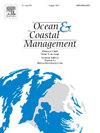Spatial response and optimisation partitioning of the impact of marine industry development on ecological vulnerability—A case study of Jiangsu coastal counties
IF 4.8
2区 环境科学与生态学
Q1 OCEANOGRAPHY
引用次数: 0
Abstract
On the basis of the theory of human–ocean regional systems, a marine industry classification system is established from a natural resource management perspective, the spatial response mechanism of the impact of marine industry development on ecological vulnerability is investigated, and space-optimised partitioning of the industrial layout is proposed. The case study results reveal the following: (1) Marine industries with different resource exploitation and utilisation characteristics exhibit distinct spatial layout patterns, and the change characteristics of ecological vulnerability are highly correlated with the spatial layout characteristics of different types of marine industries. (2) Changes in the organisation and structure of human–ocean regional system elements are subject to exogenous drivers, such as marine industry development, which induce responsive changes in the internal ecological environment of the system and exert differential impacts on the ecological vulnerability of regions dominated by different marine industries. (3) On the basis of the comprehensive index of the marine industry development level and the ecological vulnerability index of different grid cells, grid cells with marine industries are divided into industrial-scale control zones, eco-development coordination zones and ecological conservation priority zones, and differentiated spatial layout optimisation paths for marine industries are proposed on the basis of the characteristics of each functional division. This case study can provide insights into high-quality marine industry development and offer reference data for practice development in the study area.
海洋产业发展对生态脆弱性影响的空间响应与优化分区——以江苏沿海县域为例
基于人-海区域系统理论,从自然资源管理角度构建海洋产业分类体系,研究海洋产业发展对生态脆弱性影响的空间响应机制,提出产业布局的空间优化分区。研究结果表明:(1)不同资源开发利用特征的海洋产业空间布局格局不同,生态脆弱性变化特征与不同类型海洋产业空间布局特征高度相关。(2)人-海区域系统要素的组织结构变化受海洋产业发展等外源驱动因素的影响,引起系统内部生态环境的响应性变化,对不同海洋产业主导区域的生态脆弱性产生差异影响。(3)在海洋产业发展水平综合指数和不同网格单元生态脆弱性指数的基础上,将具有海洋产业的网格单元划分为产业规模控制区、生态发展协调区和生态保护优先区,并根据各功能分区的特点,提出了差异化的海洋产业空间布局优化路径。本案例研究可以为海洋产业的高质量发展提供见解,并为研究区域的实践发展提供参考数据。
本文章由计算机程序翻译,如有差异,请以英文原文为准。
求助全文
约1分钟内获得全文
求助全文
来源期刊

Ocean & Coastal Management
环境科学-海洋学
CiteScore
8.50
自引率
15.20%
发文量
321
审稿时长
60 days
期刊介绍:
Ocean & Coastal Management is the leading international journal dedicated to the study of all aspects of ocean and coastal management from the global to local levels.
We publish rigorously peer-reviewed manuscripts from all disciplines, and inter-/trans-disciplinary and co-designed research, but all submissions must make clear the relevance to management and/or governance issues relevant to the sustainable development and conservation of oceans and coasts.
Comparative studies (from sub-national to trans-national cases, and other management / policy arenas) are encouraged, as are studies that critically assess current management practices and governance approaches. Submissions involving robust analysis, development of theory, and improvement of management practice are especially welcome.
 求助内容:
求助内容: 应助结果提醒方式:
应助结果提醒方式:


